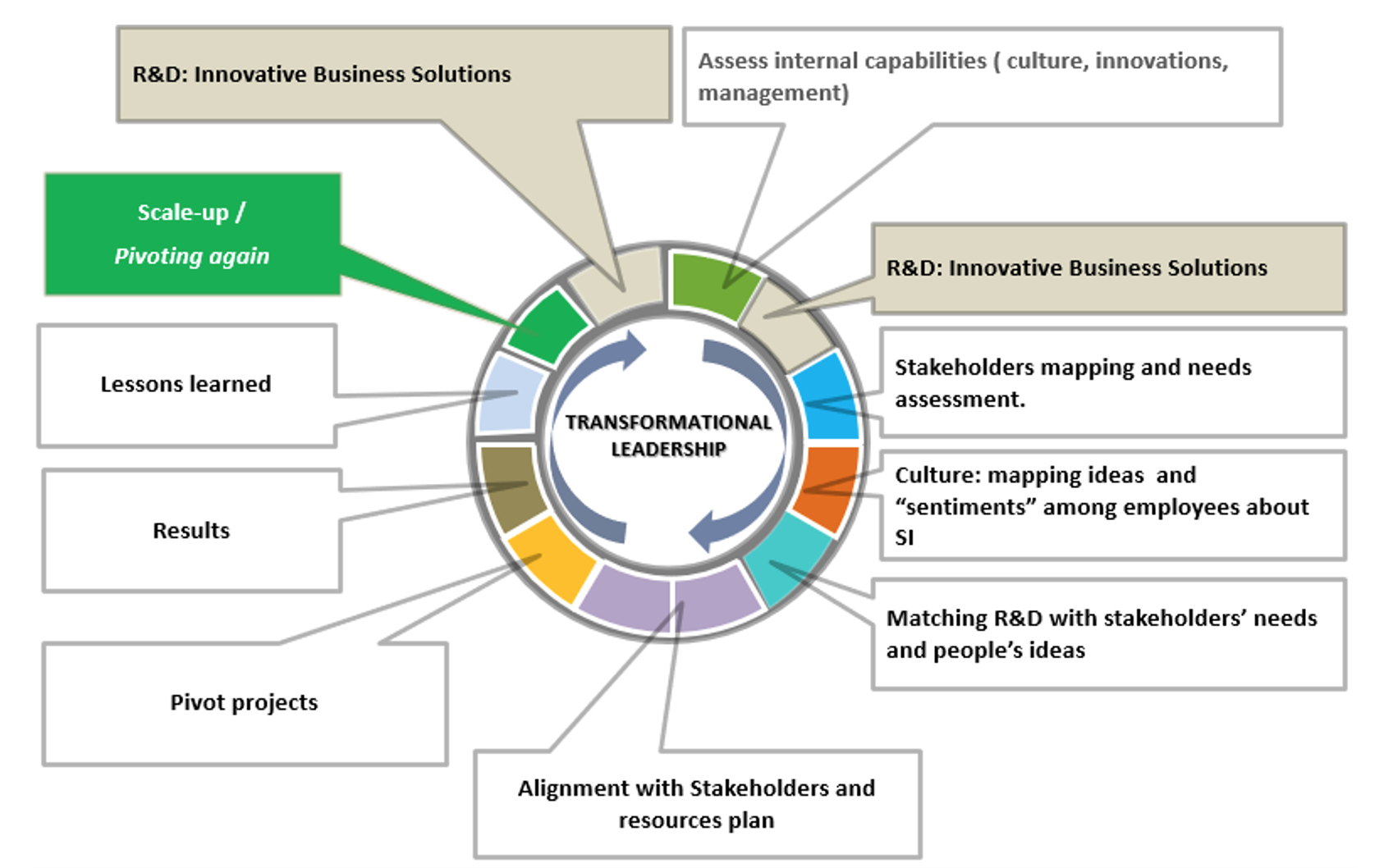California Management Review
California Management Review is a premier academic management journal published at UC Berkeley
by Luca Collina, Mostafa Sayyadi, and Michael Provitera

Image Credit | sorapop
The operational definition proposed for corporate social innovation is as practices or efforts made by corporations that aim to find and offer innovative solutions to social problems using their organization ecosystem.1, 2, 3
“Strategically Leveraging Corporate Social Responsibility: A Corporate Branding Perspective” by Christine Vallaster, Adam Lindgreen, & François Maon
“The Role of Collaboration in Achieving Corporate Social Responsibility Objectives” by John Peloza & Loren Falkenberg
More specifically, they define corporate social innovation as:
Expressing and realizing the desire to find creative solutions to social issues (primarily within the boundaries of the organizational environment);
Initiating, shaping, and coordinating activities based on the innovative capacity and capability of organizations to identify social problems
Being supported by a culture that emphasizes social innovation and requires stakeholder involvement in problem identification and solution.
The relevance assigned to the stakeholders is related to their involvement in the problem statement and the solution. In this context, companies’ resources for innovation capabilities and capacities promote a culture emphasizing social innovation.
Corporate social innovation will be considered a subset of social innovation for the purpose of this article.
Corporate social innovation has its own identity, distinguished from other forms of social support.4, 5, 6 Corporate social responsibility represents the values declaration based on ethics overarching companies’ actions toward creating benefits for social aspects.7, 8, 9 corporate social innovation works on specific innovational projects to deliver social value. It can be safely said that corporate social responsibility can be seen as the vision, while corporate social innovation is the strategy development and implementation. B-CORPS (B-Corporations) are businesses that balance purpose and profit. They are certified by a non-profit entity (B Lab) based on their social and environmental performance, transparency, and accountability. Social Entrepreneurship is a specific way to create social value by building an organization and business model to satisfy its mission. The last clarification relates to organizational innovation: it doesn’t include stakeholders or aim to generate effective societal change.
Leaders play a pivotal role in setting their company’s social vision and embedding value-creation processes within the company culture while providing an atmosphere conducive to this activity. Their support is instrumental in allocating resources, mobilizing stakeholders, and accelerating social innovation initiatives.
Shared value creation, one of the key goals of corporate social innovation and business, involves the incorporation of social innovation into an organization, taking into account its business models, structures, systems and culture (especially corporate culture). Responsiveness to society should always take precedence as this fosters lasting social value creation.
Social empathy and awareness are integral parts of successful enterprise social innovation initiatives.10, 11, 12 These abilities need to be developed over time and focused on specific social challenges to find bold, innovative solutions to overcome them. Recognizing this dimension highlights the necessity of industry-specific initiatives.
An organization’s ability to innovate in solving social problems has demonstrated its creativity by finding novel approaches to meet societal challenges using skills and technology while creating something of value to both society and business. Effective implementation must take account of structures and cultures as part of social innovation’s integration into an organization’s business model, structures, systems and culture. In other words, responsiveness must take precedence to ensure lasting social value creation.
As an important conclusive point consistent with what has been stated above, we draw particular attention to external stakeholders’ involvement, such as civil society organizations, public institutions and non-government organizations. They all play a crucial part in defining social problems and finding appropriate applications of corporate social innovation solutions. Nonetheless, employees constitute the first stakeholder group that drives social innovation by proposing and activating initiatives that foster an innovation-centric and social innovation culture.
Transformational leaders are ideal for corporate social innovation as they encourage people to think creatively and challenge existing ways rather than blindly follow the rules.13, 14, 15 Other leaders, like transactional ones, care more about rules and routines, basing reward and punishment to keep the status quo.
Transformational style works better for corporate social innovation than traditional types: leaders encourage individuals to create innovative new solutions for social problems to make a real, impactful difference. Transformational leaders get people excited about creating change and uniting all employees around a shared vision of positive changes for good that impacts internal culture and behaviors.
Studies have uncovered cultural factors which explain why some organizations exhibit more sustainable behaviors than others. One of the key cultural components required to make successful corporate social responsibility initiatives flourish is stakeholder-centric practices, which meet stakeholder needs directly; such cultural elements have also been validated through discussion and research on this matter.
One element of corporate social innovation’s culture focuses on humans’ self-realization and development embedded in organizational culture. This concept has also been highlighted when analyzing the factors that establish the elements needed by a company to put into action corporate social innovation: personal factors.
Several individual factors represent the critical elements of corporate social innovation that need to be considered: self-efficacy in personal innovation, prosocial behavior and mindset. Self-efficacy in personal innovation is seen as the expression of self-efficacy in innovation behavior, driving innovation and augmented capability of the decision-making process with higher performance in social innovation. Prosocial behavior is demonstrated when people in organizations take prosocial actions to help or protect each other, teams, and organizations through knowledge sharing, and team innovation results in being oriented towards identifying and solving social problems. Their view about practicing prosocial behavior positively impacts job satisfaction and retention. Mindset is similar to shaping and supporting people’s behaviors in an innovational culture. It is shifting away from old innovation paradigms and new values related to corporate social innovation.
These three crucial personal elements are part of the behaviors that activate corporate social innovation: support, call for ethics, and the need for consistency between ethical leadership and the perception of employees towards values related to the good in society, thus allowing the association with the company activities.
Social innovation allows businesses to enter new markets or segments while exploiting previously unexploited resources. Achieving success through social innovation requires understanding its key success factors and drivers, including contextual factors, organizational elements and managerial considerations.
Policymaker support, community participation and demand for innovation, company structures and their leaders’ guidance (contextuality) combine to allow firms to successfully develop innovations that address social problems.
Organizational elements include the business model, partnerships, participative culture and intrapreneurship, creativity, and continuous learning. Managers should act as entrepreneurs/innovators by employing practices that encourage teamwork and participation.
Switching the focus on social innovation is hard for many companies. Leaders have got to put in tons of effort to get the whole organization on board. Employees can push back because they are used to doing things a certain way. They don’t want to change their routines for new, socially focused and integrated activities.
Also, leaders must balance regular business goals like making profits and the new social impact goals. They must determine what’s best for helping society versus what makes the most money. It’s tricky to pick priorities. Measuring whether the social projects are making a difference for people is challenging. You can’t always see how much it truly helps. So, it’s tough to know the value created, especially during the journey’s beginning.
When you get more people and groups involved, you get more ideas, which is good. But it also means more disagreements to work through since everyone has different views. More voices make things more complicated.
Leadership poses many obstacles - getting people onboard, balancing business goals with social ones, showing impactful results and dealing with different opinions - yet leaders can overcome such hurdles by remaining committed and applying transformational leadership effectively.
GSK, the pharmaceutical giant, supports corporate social innovation by providing funding, ingredients, testing, disease models, and expert advice. They let researchers collaborate with GSK teams to develop ideas for new medicines for developing nations. This allows innovation in medicine while tackling social needs.
Virgin Money’s Digital Bank for Social Enterprises has created a specialized digital banking service to help social enterprises manage their finances more effectively. They also provide mentorship and grants to these organizations (Financial innovation with a social dimension). Some companies do more than innovate to grow their business; they also innovate to solve societal problems.
An in-depth investigation of internal capabilities is required: organizational culture, collaboration methods and leadership approaches, employee perception and sentiment analysis about social innovation. Teams can generate highly innovative solutions that significantly benefit client groups and explore novel approaches to major complex issues that match identified social needs. Stakeholders’ needs must be determined thoroughly within and outside the business and then engaged to explore their needs. Match stakeholders’ requirements with employees’ diverse ideas for market solutions as well as manager proposals in an efficient fashion. Then pilots are the most efficient way to test both ideas, cultural adoption and business results and social impact: lessons learned.

Figure 1 - A Road Map for Corporate Social Innovation
Businesses can create innovative solutions to social problems through corporate social innovation. It benefits both communities and companies: companies gain insight into people’s needs while rallying support among employees to address those needs collectively. Leaders should foster innovative thought. Their company cultures should welcome any fresh approaches that aim to better society. Employees should feel they can make a change and seek ways to do good work for the community. Leaders should integrate caring about the community into their values, actions, environments, learning processes, and responsibilities. This means caring about society, making it part of every employee’s goal, environment, learning process or responsibility structure.
Saka-Helmhout, A., Chappin, M.H. & Rodrigues, S.B. (2022). Corporate Social Innovation in Developing Countries. Journal of Business Ethics, 181(3), 589-605. https://doi.org/10.1007/s10551-021-04933-x
Brandsen, T., Evers, A., Cattacin, S., Zimmer, A. (2016). Social Innovation: A Sympathetic and Critical Interpretation. In: Brandsen, T., Cattacin, S., Evers, A., Zimmer, A. (eds) Social Innovations in the Urban Context (pp. 3–18). Nonprofit and Civil Society Studies. Springer, Cham. https://doi.org/10.1007/978-3-319-21551-8_1
Dionisio, M. & de Vargas, E.P. (2020). Corporate social innovation: A systematic literature review. International Business Review, 29(2), https://doi.org/10.1016/j.ibusrev.2019.101641
Fischer, M. et al. (2023). Social Innovation (or Why We Need the Civil Society). In: Sustainable Business. SpringerBriefs in Business (pp. 77–89). Springer, Cham. https://doi.org/10.1007/978-3-031-25397-3_5
Hallonsten, O. (2023). The Innovation Society. In: Empty Innovation (pp. 1-13). Palgrave Macmillan, Cham. https://doi.org/10.1007/978-3-031-31479-7_1
Satalkina, L. & Steiner, G. (2022). Social Innovation: A Retrospective Perspective. Minerva 60, 567–591 (2022). https://doi.org/10.1007/s11024-022-09471-y
Fordham, A.E. & Robinson, G.M. (2018). Mapping meanings of corporate social responsibility – an Australian case study. International Journal of Corporate Social Responsibility, 3 (1), 1-21. https://doi.org/10.1186/s40991-018-0036-1
Siltaloppi, J., Rajala, R. & Hietala, H. (2021). Integrating CSR with Business Strategy: A Tension Management Perspective. Journal of Business Ethics, 174, 507–527. https://doi.org/10.1007/s10551-020-04569-3
Fatima, T. & Elbanna, S. (2023). Corporate Social Responsibility (CSR) Implementation: A Review and a Research Agenda Towards an Integrative Framework. Journal of Business Ethics, 183, 105–121 (2023). https://doi.org/10.1007/s10551-022-05047-8
McDonnell-Naughton, M., Păunescu, C. (2022). Facets of Social Innovation in Higher Education. In: Păunescu, C., Lepik, KL., Spencer, N. (eds) Social Innovation in Higher Education. Innovation, Technology, and Knowledge Management (pp. 9-35). Springer, Cham. https://doi.org/10.1007/978-3-030-84044-0_2
Pangriya, R. (2019). Hidden aspects of social entrepreneurs’ life: a content analysis. Journal of Global Entrepreneurship Research, 9(1), 1-19. https://doi.org/10.1186/s40497-019-0199-6
Yitshaki, R., Kropp, F. & Honig, B. The Role of Compassion in Shaping Social Entrepreneurs’ Prosocial Opportunity Recognition. Journal of Business Ethics, 179, 617–647 (2022). https://doi.org/10.1007/s10551-021-04860-x
Ravet-Brown, T.É., Furtner, M. & Kallmuenzer, A. (2023). Transformational and entrepreneurial leadership: A review of distinction and overlap. Review of Managerial Science. https://doi.org/10.1007/s11846-023-00649-6
Khan, H., Rehmat, M., Butt, T.H., Farooqi, S. & Asim, J. (2020). Impact of transformational leadership on work performance, burnout and social loafing: a mediation model. Future Business, 6(1), 1-13. https://doi.org/10.1186/s43093-020-00043-8
Chughtai, M.S., Syed, F., Naseer, S. & Chinchilla, N. (2023). Role of adaptive leadership in learning organizations to boost organizational innovations with change self-efficacy. Current Psychology. https://doi.org/10.1007/s12144-023-04669-z